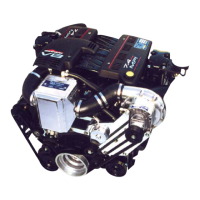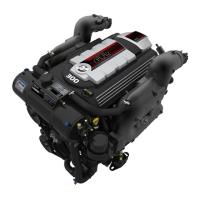7. It is not the PCM. Just because you replace the PCM and the problem seems to go away does not mean that the PCM was
bad. There are many reasons that replacing a good PCM could make a problem disappear.
• The simple act of unplugging and plugging the PCM connectors can clear oxidation from the contacts and restore a
bad connection.
• Simply moving the harness as you unplug the connectors and then reconnect them to the replacement PCM can
cause an open or short to disappear.
• A marginal actuator that is pulling too much current may cause the PCM to fail, but will work for a while with the new
PCM. This causes many technicians to assume the PCM was the root cause, when it was actually the result of the
root cause.
• The replacement PCM may have an updated calibration that eliminates the running quality issue you may have been
experiencing. This is not a PCM failure, since reprogramming the original PCM with the new calibration would have
also fixed the problem
Visual/Physical Check
1. Ensure that the safety lanyard is correctly installed and that the customer understands the correct starting procedure.
2. Verify that the battery is fully charged and of sufficient capacity for the engine being tested. If necessary, substitute a
known good battery.
3. Check the fuses and circuit breaker.
4. Check the battery cable connections. Ensure that they are clean and tight. If wing nuts are being used, discard them and
replace them with corrosion‑resistant hex nuts. A corrosion‑resistant terminal cable washer nut should be installed between
the battery terminal and the cable end (the stack sequence must be battery terminal, washer, cable, and nut). Ensure that
the cable connections are tight at the starter solenoid and that the block fuse on the starter solenoid is tight and the through
bolt is not loose. Also ensure that the ground stud is not loose in the engine block and that the nut is tight.
5. Check that all grounds are clean and tight. If the negative battery cable is connected to the ground stud that does not
contain all of the EFI and engine wiring harness ground leads, consider moving the negative battery cable to that ground
stud.
6. If there is any doubt about the mechanical condition of the engine, perform a compression test and a cylinder leak‑down
test.
!
WARNING
Performing tests with the engine running may cause the propeller to rotate and result in serious injury or death. Use caution
when performing a test that requires the engine running, and remove the propeller to avoid injury.
7. Unplug and inspect the main harness connector between the engine and boat harnesses. If there is any doubt about the
boat harness, substitute a shop harness and key switch assembly, and rerun the boat. If the problem disappears, the
problem is in the boat harness, not the MerCruiser engine harness. For non‑DTS engines, a test harness can be
purchased: MerCruiser 2‑foot instrument harness cable for 14 pin (84‑896537K02).
NOTE: The red/yellow wires for the neutral safety switch on this harness must be tied together to crank the engine and
perform this test.
8. Check for adequate fuel pressure at the fuel rail.
a. If there is no fuel pressure, check that all fuel pumps are actually operating. The pumps must run for at least two
seconds each time the key is turned to the on position. If the fuel pumps and the warning horn are not operating as
the key is turned on, ensure that the PCM is powering up (check the fuses and the wake‑up line).
b. On PCM models, fuel pressure varies with engine vacuum. Fuel pressure will be high during cranking, lower at idle,
and increase proportionally as the throttle is opened to the wide‑open position. Disconnect the vacuum line on the
fuel regulator to find the regulator’s rated pressure. Connect the vacuum line to ensure that the pressure drops at idle.
Pressure usually drops about 28–41 kPa (4–6 psi) at idle (from the regulator’s rated specification).
NOTE: Refer to
Section 5A
‑
Fuel Pressure Specifications
.
c. If the fuel pressure drops at higher speed and higher engine loads, check for restrictions in the boat’s fuel system by
connecting an accurate vacuum gauge and a clear hose at the water‑separating fuel filter inlet. As you run the engine
from idle to wide‑open throttle and then back to idle, there must not be any air bubbles passing through the clear hose
and the vacuum gauge must not read higher than 6.7 kPa (2 in. Hg). Refer to MerCruiser Service Bulletin 99‑7 for
additional information.
d. If the supply system tests OK, but the fuel pressure is low at high speeds and loads, replace the water‑separating fuel
filter and retest. If pressure is still low, most likely the fuel pump or regulator is defective.
9. Check all vacuum lines for splits, kinks, and proper connections. The fuel regulator on all PCM models must be connected
to the manifold vacuum. The PCV valve, if equipped, is a calibrated air leak. If it is missing or plugged, or if the incorrect
valve is installed, engine operation will be affected.
10. Check for any other additional air leaks in the induction system, such as at the throttle body and intake manifold gaskets.
Troubleshooting
90-8M0099748 eng DECEMBER 2015 © 2016 Mercury Marine Page 1D-3
